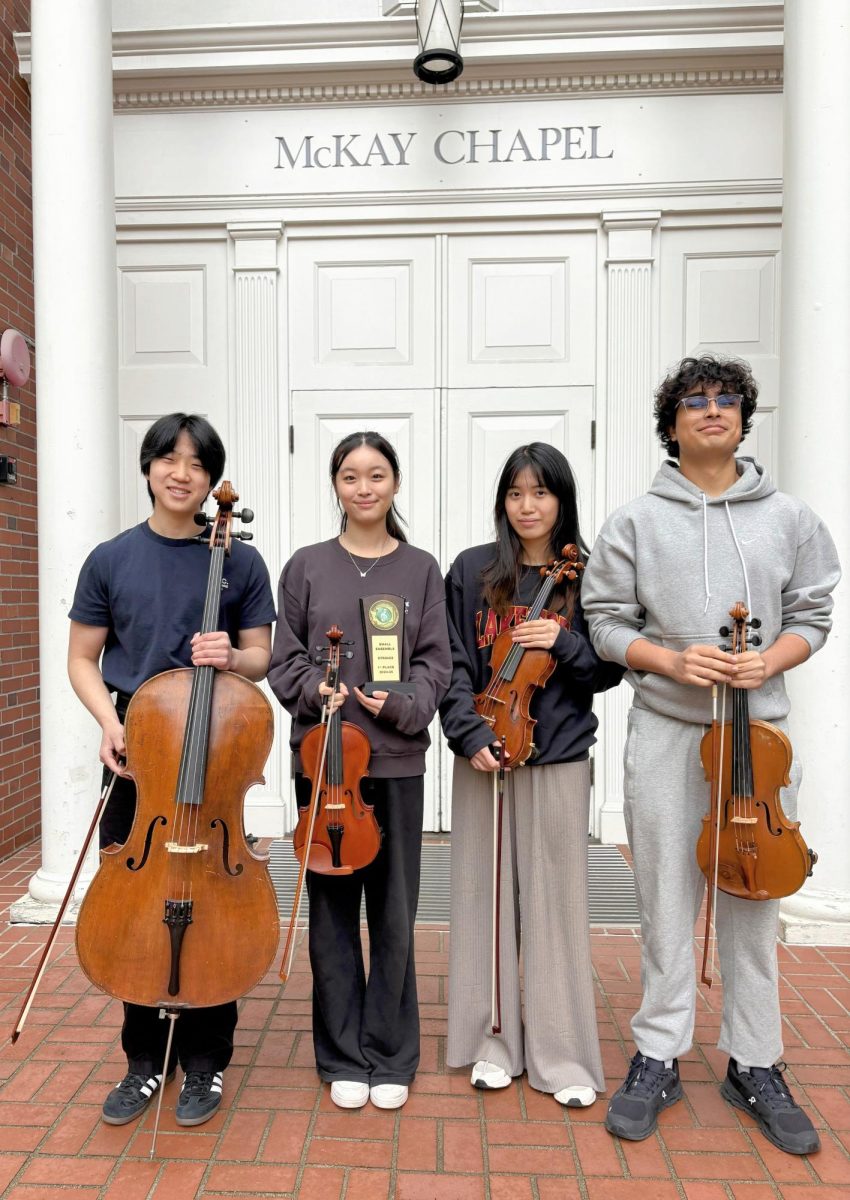“The entire experience of preparing and working together, and then in the end accomplishing this goal together — there’s very much this sense of teamwork and collective pride in our group, and I think that’s something really special,” remarked Caileen W. ’27 when reflecting on what she enjoyed most about the experience of preparing for and performing at the annual WMEA Solo & Ensemble Contest. After a strong performance overall at the regional level, Lakeside sent five students across three categories this year to compete at the state level for Solo & Ensemble. In addition to Caileen, who qualified for state in both the solo violin and piano categories, other Lakeside students included Elinor C. ’25 (viola), Jer-Shyan C. ’25 (violin), Charlie L. ’26 (cello), and Kabir S. ’27 (viola). Jer-Shyan, Charlie, Caileen, and Kabir performed in the small strings category as the “Egriegous Quartet,” while Elinor performed in the solo viola category.
Behind all good results are countless hours of hard work and preparation, and it was no different for these performers. Elinor remembers having to experiment with a variety of practice techniques to work on difficult passages in the piece that she performed — “Allegro Appassionato for Viola and Piano, Op. 34” by Henri Büsser. “I started working on the piece at the beginning of the school year,” Elinor recalls. “It definitely took a long time to get it to performance standard — after I learned all the notes, I had to get it up to speed, and I had to do a lot of work on the shifting, arpeggios and the double stops at the end.” Elinor also remembers having to work on releasing tension and relaxing during her performance, as well as refining her piece even more by thinking about its character and its storytelling aspect.
For the Egriegous Quartet, who performed Edvard Grieg’s only string quartet — “String Quartet No. 1 in G Minor, Op. 27” — the preparation process was centered on fostering a connection between each of the four players and creating a blended, cohesive sound. “We started in September — we had our sights set on Solo & Ensemble, which is why I think we started so early,” Charlie recalled. He also mentioned the importance of knowing the parts of everyone else in the chamber group, and spoke to the importance of balancing and blending the sound of the ensemble as a whole. The group also rehearsed extensively, often meeting at Caileen’s house, during activity periods, and at lunch. Caileen mentioned that the group also listened to several professional recordings to gain inspiration for the ensemble’s musical interpretation. Lastly, the group also benefited from practice performance opportunities — “Whether it be us performing in the master class for the Apple Hill string quartet, or performing for the class before going to state, those performance opportunities are definitely really helpful in preparing for a larger stage,” Caileen added.
Another major aspect of Solo & Ensemble is the performance itself, which can pose significant challenges to musicians due to nerves getting in the way, the different environment, and the added pressure of the situation, among other things.
“I actually really do enjoy performing,” said Caileen. “I think it’s something that has changed over the past few years.” She recalls previously being deathly scared of performing, but being empowered by the impact of social connection. “Having a community of people who are genuinely there to root for you is something that can really bring up your confidence and your performing skills,” Caileen noted.
Charlie explains that for him, performing became easier as he did it more often, and that we shouldn’t think of performing as a time to show off and execute a piece flawlessly. “Performing can get stressful if you feel that you have to play everything perfectly,” he says. “You have to come to terms with the fact that you’re not going to be able to drastically improve minutes before [the performance] and embrace what you’ve already practiced.”
“I do like performing — I love playing music that I enjoy for family and other musicians,” Elinor remarks. “It’s really exciting and makes me feel accomplished, but also difficult, so I just try to prepare myself in advance, and then trust myself and enjoy playing the music with my pianist.” Furthermore, playing chamber music adds an extra dimension to the performance, and requires players to be extra alert during rehearsals and performances. This is because in addition to one’s own sound, one also has to closely listen to the playing of the other chamber musicians, adjust intonation, volume, bow speed, etc., and also communicate with eye contact and cueing to ensure that the ensemble stays together. “I think ultimately, with music, you’re trying to communicate something, and that surpasses playing in tune or playing a passage perfectly,” Charlie explained. “[During the performance], I was trying to exaggerate all the emotions, so that even people at the farthest point in the room could hear a contrast and interpret some feelings from my playing.” In a similar manner, Caileen spoke to the importance of listening across the group, stating that, “I’m always looking up, and I’m always thinking about how I can adjust to make our collective sound better. A lot of it is in the moment, so you have to be really attentive and try to adjust as you go.”
With each competition comes its own challenges throughout the process of both preparing and performing. Whether it’s mastering a difficult shift or agreeing on a musical interpretation, overcoming these challenges is necessary for a successful performance. “I definitely had a hard time polishing [the piece] and making sure my shifts and double stops were in tune,” Elinor reflected. She also adds that a major challenge for her was when after hours of hard work and practice, she didn’t see much progress with her piece. “I had to be resilient, which was hard for me, but I kept at it and focused on specific things I could do to improve with each practice session.” In the realm of chamber music, Caileen explained that a major challenge was resolving disagreements for how the quartet should’ve approached learning the music, as well as rehearsals in general. “It’s something that’s always going to be present because of our differences in musical education and upbringing,” she explained. “It’s definitely something that we tried to work around by being considerate of other people and making compromises.” Charlie elaborated on the importance of being conscious of your own sound, and how that fits into that of the larger group. “It’s really difficult to explain concepts like blending and actively supporting in just words, so it’s really dependent on you recognizing that when you play like this, that’s when the group sounds better, and then if you play like this, maybe it’s not as good … that was a huge, huge hurdle.”
To offer an additional insight into what the experience was like for these performers, and to contrast the challenges they faced, I asked them to think of a moment in their preparation or during the performance that made them especially proud. For Elinor, this moment was during her performance at the regional competition. “My performance was going really well, and when I got to the end, I decided not to be scared of the double stops and to just go for it and enjoy it,” she recalls. “It turned out sounding really good…I felt really proud of that because it was definitely one of the most difficult parts.” For the quartet, some proud moments were — understandably — winning regionals and playing well at state, which led to a first place win. “Going up to regionals, there were definitely some worries that we wouldn’t win or that other groups would be better,” Caileen explained. “Getting that win was really validating for the group, and made us proud of ourselves.” Charlie recalls feeling concerned regarding the state of the ensemble following an unsatisfactory performance the day before the state competition, which they were fortunately able to turn around. “The day before [state] when we performed for the orchestra, it felt super iffy,” he noted. “I felt like when we were at state, everyone was so alert and aware of their surroundings and communicating … that’s kind of when everything we practiced came together.”
Ultimately, with their outstanding performances and dedication to excellence, these students have proven that the future of music at Lakeside is in talented hands.They are a testament to music’s power to inspire, connect, and bring joy. As Caileen put it, “chamber [music] is so fun in the way that not only do you get to make wonderful music, but you also get to make it with people that you love, and people that are fun and enjoyable to be around.”
Categories:
The Journey of Lakeside Musicians to Solo and Ensemble Success
Oliver T., Staff Writer
Jun 4, 2025

